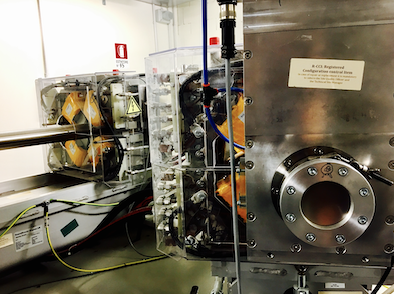Speaker
Description
Within the MoVeIT project of the National Institute for Nuclear Physics (INFN), the University of Torino and the INFN are investigating Ultra-Fast Silicon Detectors (UFSD) for proton beam monitoring in order to replace ionization chambers currently in use in Hadrontherapy.
Two devices are being developed based on UFSD: one for measuring the beam energy using Time-of-Flight (ToF) techniques, and the other aiming at counting single particles up to 100 MHz/$cm^2$. Strip sensors of two geometries {20 strips of 2.25 $mm^2$ (150 $\mu$m width x 15000 $\mu$m length, 216 $\mu$m pitch); 30 strips of 2.40 $mm^2$ (80 $\mu$m width x 30000 $\mu$m length, 146 $\mu$m pitch)} produced by FBK (Fondazione Bruno Kessler, Trento, Italy) were used for counting, while pads (80 $\mu$m active thickness, 3x3 $mm^2$ sensitive area) produced by HPK (Hamamatsu Photonics K.K., Japan), and strip sensors (600 $\mu$m pitch, 50 $\mu$m active thickness, 2.2 $mm^2$ sensitive area) produced by FBK were used for energy measurement. Tests for preliminary characterization were performed in the experimental room of the Trento Proton Therapy Center (Azienda Provinciale per i Servizi Sanitari, APSS), with 60-250 MeV clinical proton beams at $10^6$ − $10^9$ p/s fluxes. Varying the flux at different energies, the particle rate was measured and compared with the one estimated by a pin-hole ionization chamber. The energy was obtained using ToF measurements from the telescope of two UFSDs sensors placed at a specific distance between each other and aligned along the beam direction.
The achieved efficiency of the counter prototype was greater than 98 % up to $10^8$ p/s*$cm^2$ and few hundreds of keV deviations from nominal energies were achieved for all beam energies at 67 and 97 cm distance between the sensors corresponding to < 1 mm range.
These promising results demonstrate that UFSD could be a viable option to improve the conventional monitors and further improvements are therefore being developed. Among them, a new detector geometry is being produced by FBK to cover a sensitive area of 2.74 x 2.74 $cm^2$ and will be tested in the coming months, it features 146 strips of 114 $\mu$m width x 26214 $\mu$m length, 180 $\mu$m pitch.

